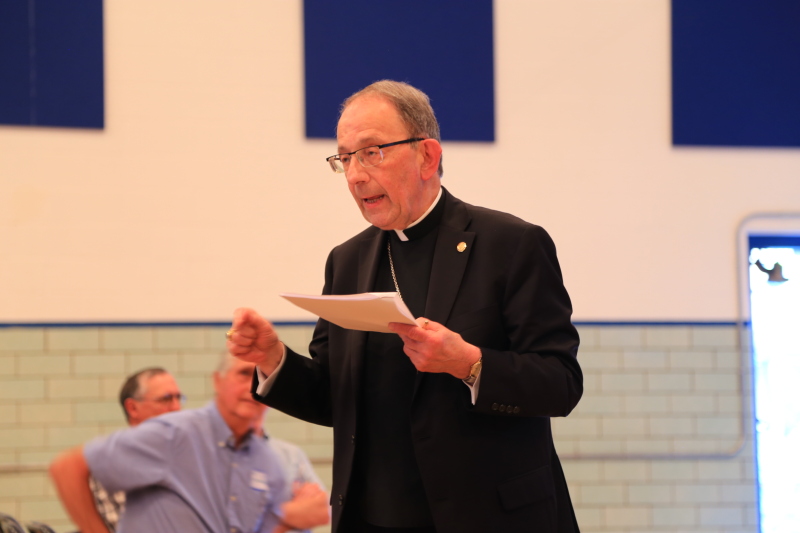
BISHOP LAWRENCE PERSICO DEANERY PLANNING MEETING REMARKS
The Most Rev. Lawrence T. Persico, Bishop of Erie
06/06/2022
.jpg)
NORTHWEST PA — Thank you very much for being here today.
I trust many of you participated in the recent opportunities we had for parishioners to share their insights in preparation for the Synod on Synodality that will be held in Rome in 2024.
In calling us to synodality, the Holy Father is asking that we all live out our vocations to the fullest extent possible. That we all participate in building the Kingdom of God.
Fortunately, in our diocese, we’ve been practicing synodality throughout pastoral planning. In 2015, we took a serious look at our future, developing preliminary proposals, offering opportunities for feedback, and refining plans before implementing final decisions concerning our schools, our parishes, our vocation initiatives and our lifelong faith formation efforts. Along the way we also reformed administrative offices to better meet today’s needs.
Early on, I said planning would have to be a way of life, so here we are, seven years later, ready to get serious about the next phase of planning.
It’s very important that as parish leaders, you have a full understanding of the process we are continuing and why.
Things are changing very rapidly in this region of the country, from New England through the Mid-Atlantic states. It may not feel rapid at the local level…in fact, it can be easy to ignore changes that seem gradual when considered on a day-to-day basis.
But unfortunately, that is not the case.
Today, we’re going to share new data with you, updating demographic information pertinent to the (Oil City) (West Erie) (Bradford) Deanery.
Some of that has to do with the population. It’s no secret that we have far more funerals than baptisms in most of our parishes. We have to look at our realities.
As we saw in the first round of pastoral planning, we are not just losing parishioners. The number of priests available to serve our parishes also is dwindling. Msgr. Lohse recently mentioned that when he was ordained in 1989, we had 220 active priests in our diocese. Today, we have 109, and projections are that just nine years from now, the number is likely to be 65. Currently we have 94 parishes, so you can see the writing on the wall.
I had the pleasure of ordaining three wonderful men to the priesthood this past weekend, and I am deeply grateful to their families, to all the people who taught them and nurtured their vocations while they were in seminary, and to God for blessing us with the gift of their vocations. But while we have three new priests, we have five priests retiring, and of course Father Jim Kennelley recently went to his eternal reward.
That trend will continue.

meeting held at Immaculate Conception Parish in Clarion. Photo/Anne-Marie Welsh
As we plan for our future, we must consider how we can help our priests maintain their spiritual, physical and mental well-being so that they can, in turn, provide the best possible pastoral care to the souls that have been entrusted to them.
Let me stop here for a moment to reiterate that the singular driving force behind all pastoral planning is to ensure that people in every corner of the diocese can continue to grow in their love of Christ. Everyone deserves to be part of a vibrant worship community.
Our priests are a key to parish vitality, and we have taken many steps to provide for priestly renewal in recent years. This is another priority and ongoing commitment I have made, and part of that renewal includes exploring ways to allow the laity to fulfill their roles in parishes. So again, I’m grateful for the presence of each of you today.
While we are focusing on three deaneries in this next phase of pastoral planning — Oil City, West Erie and Bradford — I remind you that we are all in this together. We don’t always pay attention to what is happening in the diocese until it hits home.
I don’t think it’s news to anyone in this room that there is a sense of urgency regarding planning for the (Oil City) (West Erie) (Bradford) Deanery. Today we will review data that the Meitler firm has prepared at my request. You may remember that Meitler did the same for us in our first phase of planning, and we are grateful that Mark Kemmeter, who got to know us at that time, has returned to accompany us again.
The information Meitler has gathered is a resource designed to give you confidence, allowing you to consider plans for the future based on information, not on best guesses.
In addition to data, Mark will present some new models of collaboration for you to consider. I’m excited and hopeful about the creativity this will inspire — we simply cannot afford to remain in our silos.
The final page of the report Mark is presenting to you today has three calls to action. I will let him walk you through them. But I cannot say strongly enough how important it is for you to follow through on this process in the next two months. If progress does not occur, it will fall to me to make decisions for you.
I know it’s not an easy moment. But it is our reality.
We can be victims of change or agents of change.
I have experienced such generosity, faith and hope among the people of the Diocese of Erie. I absolutely believe with the help of the Holy Spirit we can rise to the challenge of the moment.
Thank you.
-
